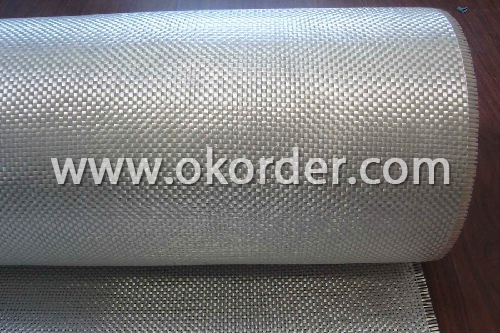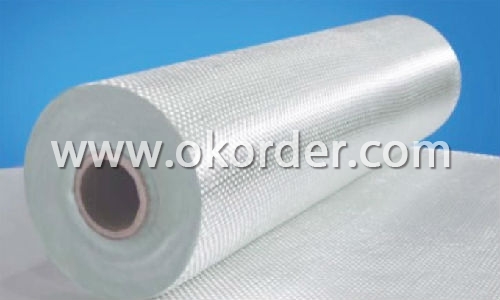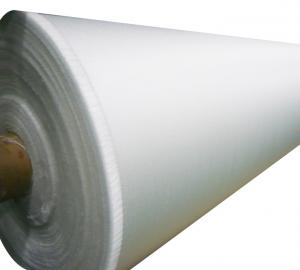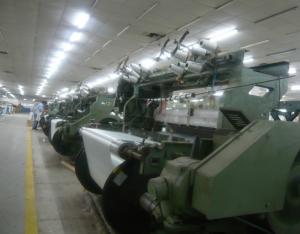Manufacturer of Fiberglass Fabrics 100g
- Loading Port:
- Shanghai Port
- Payment Terms:
- TT or LC
- Min Order Qty:
- 10000 M2 m²
- Supply Capability:
- 50000000 M2 Per Year m²/month
OKorder Service Pledge
OKorder Financial Service
You Might Also Like
Introduction of Fiberglass Fabric:
Fiberglass fabric is corrosion resistance, high intensity, electricity insulation, compatibility with other resin.Fiberglass fabric is widely used into electric insulation field for PCB or copper clad laminate.
Specifications of Fiberglass Fabric:
Fabric Count Warp×Fill(Per cm)
| Yarn(SI)
| Thickness(mm) (Rreference Only)
| Nominal Weight(g/m2)
| Weight Tolerance(g/m2) |
23.6×18.5 | 5 11 1×0 5 11 1×0 | 0.053 | 46.8 | 45.1-48.5 |
23.6×23.6 | 5 11 1×0 5 11 1×0 | 0.056 | 52.9 | 51.5-54.2 |
19.3×16.5 | 7 45* 1×0 7 45* 1×0 | 0.149 | 164.1 | 157.7-170.5 |
18.1×17.7 | 7 45* 1×0 7 45* 1×0 | 0.140 | 1654.0 | 158.0-171.0 |
23.6×19.7 | 6 33 1×0 6 33 1×0 | 0.125 | 148.0 | 142.8-153.2 |
20.0×10.8 | 9 331×0 9 74 1×0 | 0.135 | 146.2 | 142.1-150.3 |
20.5×20.5 | 9 34* 1×0 9 34* 1×0 | 0.114 | 138.3 | 133.6-143. |
23.6×22.0 | 7 22 1×0 5 11 1×0 | 0.079 | 78.0 | 75.6-80.4 |
22.0×18.9 | 7 22 1×0 7 22 1×0 | 0.084 | 90.9 | 88.5-93.2 |
23.6×22.8 | 7 22 1×0 7 22 1×0 | 0.094 | 103.8 | 100.7-106.8 |
26.0×21.7 | 7 22 1×0 7 22 1×0 | 0.095 | 108 | 104.8-111.2 |
17.3×12.2 | 9 681×0 9 68 1×0 | 0.173 | 203.4 | 198.0-208.9 |
17.9×13.4 | 9 68 1×0 9 68 1×0 | 0.18 | 210.0 | 204.5-215.3 |
17.3×11.4 | 9 68 1×0 9 102* 1×0 | 0.201 | 232.3 | 226.5-238.0 |
17.5×7.9 | 9 68 1×0 9 136* 1×0 | 0.254 | 227.8 | 221.1-234.7 |
17.4×10 | 9 68 1×0 9 136* 1×0 | 0.250 | 260.0 | 255.2-265.3 |


- Q:What's the difference between glass fiber tape and fiberglass tape?
- One tape, one is the base material, no adhesive. Fiberglass is glass fiber.
- Q:Can fiberglass fabric be used for ducting?
- Yes, fiberglass fabric can be used for ducting. Fiberglass is a lightweight and flexible material that has excellent insulation properties. It is often used in the construction of air ducts to help maintain the temperature and airflow of the system. Fiberglass fabric can be wrapped around the ducts or used as lining to provide thermal insulation and prevent heat transfer. Additionally, fiberglass is resistant to moisture, mold, and mildew, making it a suitable choice for ducting in humid environments. However, it is important to note that fiberglass fabric should be properly installed and sealed to ensure proper air quality and prevent any loose fibers from entering the duct system.
- Q:What are the different lamination options available for fiberglass fabric?
- There are several lamination options available for fiberglass fabric, depending on the specific requirements and applications. Some of the common lamination options include: 1. Polyester Resin Lamination: This is the most commonly used lamination option for fiberglass fabric. Polyester resin is applied to the fabric, forming a strong and durable bond. It provides good chemical resistance and is suitable for applications where high strength is required. 2. Epoxy Resin Lamination: Epoxy resin lamination offers superior strength and excellent adhesion. It is often used in applications that require high-performance and resistance to harsh environmental conditions. Epoxy resin also provides good chemical and heat resistance. 3. Polyurethane Lamination: Polyurethane lamination offers flexibility and excellent abrasion resistance. It is commonly used in applications that require fabric flexibility and durability, such as inflatable structures or protective clothing. 4. Vinyl Ester Resin Lamination: Vinyl ester resin is a hybrid between polyester and epoxy resins, offering high strength and excellent corrosion resistance. It is commonly used in applications exposed to harsh chemicals or environments, such as chemical storage tanks or marine applications. 5. Thermoplastic Lamination: Thermoplastic lamination involves the use of heat and pressure to bond a thermoplastic film onto the fiberglass fabric. This option provides good chemical resistance and is often used in applications that require waterproofing or resistance to environmental elements. It is important to consider the specific requirements and intended use of the fiberglass fabric when choosing the appropriate lamination option. Factors such as strength, flexibility, chemical resistance, and environmental conditions will help determine the most suitable lamination choice.
- Q:Polyurethane waterproof coating how to use, polyurethane waterproof coating what are the methods of use?
- Clean the grass: with the shovel sticking on the leveling layer the gray skin removed, with a broom to clean the dust, especially the root canal, drain and drain and other parts should be carefully cleaned. In case of oil pollution, apply wire brush and sand paper to brush off, or paint with an adhesive paint on the surface of the grease. The surface must be smooth, and the concave place shall be made of 1: 3 cement mortar.
- Q:How does fiberglass fabric perform in terms of dimensional stability?
- Fiberglass fabric exhibits excellent dimensional stability, making it highly reliable and suitable for a wide range of applications. Thanks to its unique composition of woven glass fibers, it possesses remarkable resistance to changes in shape or size, even under extreme temperature fluctuations or mechanical stress. This stability ensures that fiberglass fabric maintains its original dimensions and shape over time, allowing it to consistently meet the required specifications and performance criteria. Additionally, its dimensional stability makes fiberglass fabric ideal for applications where precise measurements and accuracy are necessary, such as in aerospace, automotive, and construction industries. Overall, fiberglass fabric's exceptional dimensional stability is one of its key attributes, contributing to its widespread use and popularity across various sectors.
- Q:Can fiberglass fabric be used for reinforcement in wind turbine blades?
- Yes, fiberglass fabric can be used for reinforcement in wind turbine blades.
- Q:How is fiberglass fabric used in the production of fireproof curtains?
- Fiberglass fabric is commonly used in the production of fireproof curtains due to its excellent fire-resistant properties. When exposed to high temperatures, fiberglass fabric does not burn and does not contribute to the spread of flames. In the production of fireproof curtains, fiberglass fabric is typically treated with a fire retardant chemical to enhance its fire-resistant capabilities. This treatment ensures that the curtains can withstand high temperatures and prevent the fire from spreading to other areas. Fiberglass fabric is also known for its durability and strength, making it an ideal material for fireproof curtains. It can withstand extreme heat and maintain its structural integrity, providing a reliable barrier against flames and heat transfer. Additionally, fiberglass fabric has excellent insulation properties. It can effectively block the transfer of heat, helping to contain the fire and prevent it from spreading to other parts of a building. This is crucial in fire safety, as it allows for more time for people to evacuate and for firefighters to control the fire. Moreover, fiberglass fabric is lightweight and flexible, making it easy to install and operate fireproof curtains. It can be easily manipulated and customized to fit different window sizes or openings, providing a versatile solution for fire protection. Overall, fiberglass fabric plays a vital role in the production of fireproof curtains by offering exceptional fire resistance, durability, insulation, and ease of use. Its use in fireproof curtains ensures enhanced fire safety measures in various settings, such as commercial buildings, residential homes, and industrial facilities.
- Q:What are fiberglass fabrics made of?
- Fiberglass fabrics consist of fibers made from a glass-like substance known as fiberglass. The process involves molding the fiberglass into strands, which are subsequently intertwined to form a textile. Silica, the primary component of fiberglass, is obtained from sand. To improve the fabric's performance, other elements such as limestone, soda ash, and alumina are incorporated into the mixture. These materials are subjected to a procedure called melting and extrusion, in which they are heated to elevated temperatures and then pushed through small apertures to create the slender fibers. Finally, these fibers are interlaced or looped together to produce the ultimate fiberglass fabric, renowned for its robustness, endurance, and resistance to both heat and chemicals.
- Q:Is fiberglass fabric resistant to chemicals used in wastewater treatment?
- Fiberglass fabric exhibits remarkable resistance to the chemicals employed in wastewater treatment. Its outstanding chemical resistance has earned fiberglass a reputation as an optimal material for scenarios where exposure to diverse chemicals is probable. It has the capacity to endure a broad spectrum of corrosive substances, such as acids, alkalis, and solvents, commonly encountered in wastewater treatment processes. Due to the non-reactive quality of fiberglass fabric, it remains unaffected and undamaged when exposed to these chemicals, making it a dependable choice for implementation in wastewater treatment facilities. Additionally, fiberglass fabric also offers resistance to UV radiation, moisture, and fluctuations in temperature, which further bolsters its durability and suitability for such environments.
- Q:Is fiberglass fabric resistant to electrical conductivity?
- Indeed, fiberglass fabric exhibits resistance to electrical conductivity. Comprised of interwoven glass fibers, fiberglass fabric consists of materials that are incapable of conducting electricity. Consequently, electrical current is unable to pass through fiberglass fabric. Due to its exceptional insulating properties and ability to shield against electrical shocks, it is frequently employed in electrical insulation applications. The non-conductive property of fiberglass fabric renders it a viable option for a wide range of electrical and electronic applications that necessitate prevention of electrical conductivity.
1. Manufacturer Overview |
|
|---|---|
| Location | Jiansu,China |
| Year Established | 1956 |
| Annual Output Value | |
| Main Markets | Europe, Americans, Middle East, South East Asia |
| Company Certifications | ISO9001:2008;ISO14001:2004 |
2. Manufacturer Certificates |
|
|---|---|
| a) Certification Name | |
| Range | |
| Reference | |
| Validity Period | |
3. Manufacturer Capability |
|
|---|---|
| a)Trade Capacity | |
| Nearest Port | |
| Export Percentage | |
| No.of Employees in Trade Department | |
| Language Spoken: | |
| b)Factory Information | |
| Factory Size: | |
| No. of Production Lines | |
| Contract Manufacturing | |
| Product Price Range | |
Send your message to us
Manufacturer of Fiberglass Fabrics 100g
- Loading Port:
- Shanghai Port
- Payment Terms:
- TT or LC
- Min Order Qty:
- 10000 M2 m²
- Supply Capability:
- 50000000 M2 Per Year m²/month
OKorder Service Pledge
OKorder Financial Service
Similar products
New products
Hot products
Related keywords






























